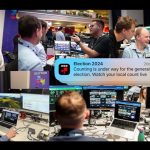With 3,000 hours of footage from across the seven continents, the BBC hopes to release one of its most ambitious natural history productions in late 2019, in the run-up to its centenary in 2022. BroadcastPro ME learns more about how drone filming and music have enriched this production during a press interview with renowned naturalist […]

With 3,000 hours of footage from across the seven continents, the BBC hopes to release one of its most ambitious natural history productions in late 2019, in the run-up to its centenary in 2022. BroadcastPro ME learns more about how drone filming and music have enriched this production during a press interview with renowned naturalist David Attenborough; Executive Producer of One Planet: Seven Worlds, Jonny Keeling; and Academy Award-winning music composer Hans Zimmer.
The BBC recently announced five new natural history programmes in the run-up to its centenary in 2022.
The line-up includes landmark title One Planet: Seven Worlds and other segments of the BBC Planet strand, including Planet Earth III, Green Planet, Perfect Planet and Frozen Planet II. Select sequences from the programme were played at the BBC Studios Showcase in Liverpool. Narrated by renowned naturalist David Attenborough, the seven-part series is expected to premiere this autumn.
At a roundtable with the press, Jonny Keeling, Executive Producer for One Planet: Seven Worlds, told us: This is the first time we have told the story like this, which is continent by continent. From where each continent sits on the planet, and its history, its size and its shape, it has a big impact on the animal life that is found there. Each continent is a one-hour episode, and each has a very different character and personality based on its geology and geography, and thats our story really. Its based on the theory that the planet was initially one enormous continent that was broken apart hundreds of millions of years ago and this brought about a fundamental change that has partly driven the diversity on Earth. So, we have one episode for each of the continents, and they are very different from each other based on their geography and position on Earth.
Asked about the criteria for selecting one story over the other to represent each continent, Keeling said: For me, the question is, is it new? Does it have multiple beats to the story, and what is the range of emotional content in it, because we cant have ten hunting sequences. We were looking at a different emotional range. In Australia, for instance, we found some very unusual animals, but they were pretty much sitting there doing nothing, so that is not a story. That makes for a great magazine photo. We looked at how to tell a story differently and how it helps to represent the theme of the continent.
“Each continent is a one-hour episode and each has a very different character and personality based on its geology and geography,” Jonny Keeling, Executive Producer, One Planet: Seven Worlds.

Africa, for instance, is showcased as a furnace, while Australia is depicted as isolated and Antarctica as hostile.
Africa has the largest land mass around the equator and its a continent with the most solar radiation in the world, and the volcanic heat beneath it has caused it to lift up and crack. Like this, we have chosen a single point of entry for each of the continents. With South America, it is so rich because it sits on the equator and there is the wonderful bowl of the Amazon. We have some great desert stories from there, said Keeling.
North Americas climate is so dramatic with the mountains in the north and the south, and the polar air and the tropical air. We cover that. In Europe, a continent of 750 million people, we have mostly heard stories around its culture and history. But Europe also has some incredible hidden wildernesses, and we have some great sequences from there that havent been shown before.
Based on the select sequences we were privy to at the show, other impressive elements of the production are noteworthy.
For one, Academy Award-winner Hans Zimmer and Bleeding Fingers Music will compose the theme and score of One Planet: Seven Worlds. Showcase attendees had the opportunity to hear how the music plays out in a sequence where fireflies light up a whole forest, and it provided incredible insight into how much thought goes into scoring a programme.

Zimmer, who has scored more than 150 films as well as Planet II and Blue Planet II, told us: What I have tried to do through my music in this programme is include humanity to bring our neighbours with whom we live closer together. Our mission is to recognise that this world is in danger. We have run out of time. Telling people all the time that it is dangerous and frightening them is not as effective as moving them. Our mission now is to move audiences a little bit, by including everyone a little bit.
One big aspect of this programme is the extensive use of drones for shooting. Drones are used to fly through caves in Europe, through volcanoes at night in Asia, and around waterfalls and really close to water and animals. Keeling explained why drone filming has been so crucial to this production and has provided a brand-new perspective to the series.
In some areas, you just could not have got that footage if it wasnt for a drone. The drones have helped us reach places we traditionally cant. Were able to see things from a long way off and film them, and thats been the challenge in the past. To be able to look down and see that planned view perspective of the whales coming in, for instance, in one episode, could not have been done without having a drone in the air for most of the day. You cant have a helicopter up all day because of the cost and the disturbance it creates.
The view of the landscape from a helicopter is also mostly a forward-looking shot, as opposed to what you get with a drone. You will see that the views of the landscape, the shapes and patterns of nature we see from drone filming, are very different and it shows our world in a very different light. With a drone, you can film behaviour you wouldnt normally see, and the perspective you get of a single animal in its landscape, for instance, helps you suddenly recognise how challenging that landscape is for that animal.

David Attenborough added at this point that with drone technology having improved vastly since his first drone shoot six years ago, he anticipates a whole new dimension of filming coming to natural history programming in the coming years that is sure to blow your mind.
With helicopters, if you go low down, you go flat on the vegetation; and if you go up, you have to struggle to get a decent shot. With drones, you can convey the grandeur of these landscapes and the iconic animals that live in these habitats. The technology has moved onward in leaps and bounds and helps you to achieve so much more. You will see this sensational sequence that was shot in South America that you just could not have filmed without drones.
Keeling explained that he had visited the Andes four previous times over the last few years, but this was the first time he managed to get some amazing footage thanks to drones. The team spent 10-12 weeks with two camera operators to get the Andes footage.
It was a huge effort, but most of our drone pilots are young and have grown up with Xboxes and seem so good at flying and manoeuvring their drones through the forest. There are some really amazing shots where they come so close to the water or to the animals, he said.
While the team joked about losing a few drones during filming, they also lamented the shrinking landscape as they return to some places. Madagascar, for instance, is said to have lost almost 80% of its forest, leaving behind just small pockets of wilderness.
The sequences we saw, the music we heard and the stories the team narrated are without doubt a reflection of a huge commitment to natural history programming and keeping animals close to the hearts of the audience, with the aim of compelling us to do more to look after our natural resources.
This entire Planet strand was born with the launch of the BBCs Planet Earth series in 2006. Green Planet, scheduled for 2021, will depict emotional stories and surprising heroes in the plant world. Perfect Planet, aiming for a 2020 release, will fuse natural history and earth sciences, while Frozen Planet II will dig deep into the wildernesses of the Arctic and Antarctica. The third season of Planet Earth will premiere in 2022.
















































































